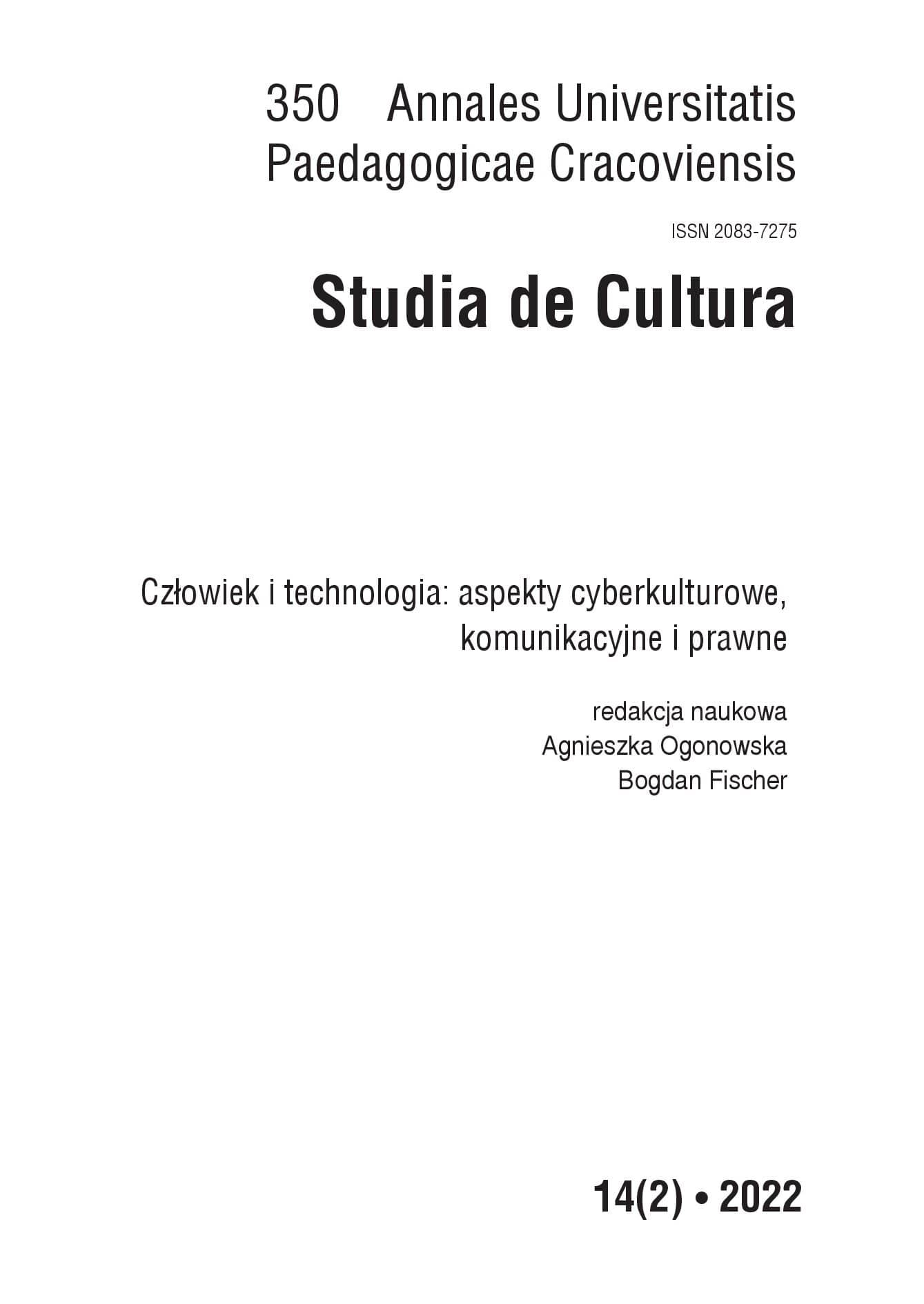Abstrakt
Artykuł przedstawia fenomen wirtualnych influencerów, którzy zyskują popularność dzięki swojej aktywności w popkulturze i w mediach społecznościowych. Jego celem jest uporządkowanie dotychczasowej wiedzy na ich temat. W celu zilustrowania zagadnienia za pomocą metody studium przypadku w artykule opisana została instagramowa gwiazda Miquela i influencerzy z Aww Inc. Na wybranych przykładach zaprezentowano modele i sposoby funkcjonowania tych bytów w dzisiejszych czasach.
Bibliografia
Black Daniel. 2008. „The Virtual Ideal. Virtual Idols, Cute Technology and Unclean Biology”. Continuum: Journal of Media & Cultural Studies t. 22, nr 1. 37–50.
Zobacz w Google Scholar
Black Taylor C. 2019. „Just a Robot Keeping It Real. Lil Miquela, Instagram, and the Performance of Authenticity”. tba: Journal of Art, Media, and Visual Culture t. 1, nr 1. „FAKE”. https://ojs.lib.uwo.ca/index.php/tba/issue/view/892. (dostęp: 29.10.2021).
Zobacz w Google Scholar
Burden David, Savin-Baden Maggi. 2019. Virtual Humans Today and Tomorrow. Boca Raton.
Zobacz w Google Scholar
Crystal Abidin. 2018. Internet Celebrity. Understanding Fame Online. Bingley.
Zobacz w Google Scholar
Gibson William. Idoru. Zbigniew A. Królicki (przeł.). Katowice.
Zobacz w Google Scholar
KA Yan Lam. 2016. „The Hatusne Miku Phenomenon. More Than a Virtual J-Pop Diva”. The Journal of Popular Culture t. 49, nr 5. 1107–1124.
Zobacz w Google Scholar
Kaplan Frédéric. 2004. „Who Is Afraid of the Humanoid? Investigating Cultural Differences in the Acceptance of Robots”. International Journal of Humanoid Robotics t. 1, nr 3. 1–16.
Zobacz w Google Scholar
Konefał Sebastian Jakub. 2013. Corpus futuri. Literackie i filmowe wizerunki postludzi w anglosaskiej fantastyce naukowej oraz ich komiksowe i telewizyjne reinterpretacje. Gdańsk.
Zobacz w Google Scholar
MacDorman Karl F., Vasudevan Sandosh K., Chin-Chang Ho. 2009. „Does Japan Really Have Robot Mania? Comparing Attitudes by Implicit and Explicit Measures”. AI & Soc t. 23, nr 4. DOI 10.1007/s00146-008-0181-2.
Zobacz w Google Scholar
Magnenat-Thalmann Nadia, Thalmann Daniel. 2004. An Overview of Virtual Humans. W: Handbook of Virtual Humans. Nadia Magnenat-Thalmann, Daniel Thalmann (red.). Chichester West Sussex. 1–26.
Zobacz w Google Scholar
Marwick Alice E. 2019. The Algorithmic Celebrity. W: Microcelebrity Around the Globe. Crystal Abidin. Megan Lindsay Brown (red.). Bingley. https://doi.org/10.1108/978-1-78756-749-820181015. (dostęp: 19.05.2022).
Zobacz w Google Scholar
Radkowska-Walkowicz Magdalena. 2008. Od Golema do Terminatora. Wizerunki sztucznego człowieka w kulturze. Warszawa.
Zobacz w Google Scholar
Robinson Ben. 2020. „Towards an Ontology and Ethics of Virtual Influencers”. Australasian Journal of Information Systems t. 24, Selected papers from the 2019 AiCE Conference. https://journal.acs.org.au/index.php/ajis/article/view/2807. (dostęp: 29.10.2021).
Zobacz w Google Scholar
Travers Christopher Travers. 2020. What Is a Virtual Influencer? Virtual Influencers, Defined and Explained. https://www.virtualhumans.org/article/ what-is-a-virtual-influencer-virtual-influencers-defined-and-explained. (dostęp: 29.10.2021).
Zobacz w Google Scholar
Wojciechowski Piotr. 2013. „Jak człowiek stworzył człowieka. Geneza zjawiska sztucznych ludzi w kulturze”. Kultura Popularna nr 2(36). 94–111.
Zobacz w Google Scholar
@imma.gram. Post z 28 grudnia 2020. https://www.instagram.com/p/ CJVUr46DsW6/? utm_source=ig_web_copy_link. (dostęp: 29.10.2021).
Zobacz w Google Scholar
@lilmiquela. Post z 19 kwietnia 2018. https://www.instagram.com/p/ BhwuJcmlWh8/? utm_source=ig_embed. (dostęp: 29.10.2021).
Zobacz w Google Scholar
Asia Trend. Japanese Virtual Model Imma. https://asiatrend.org/lifestyle/fashion/ japanese-virtual-model-imma/. (dostęp: 29.10.2021).
Zobacz w Google Scholar
Bartneck Christoph [i in.]. 2007. The Influence of People’s Culture and Prior Experiences with Aibo on Their Attitude towards Robots. https://www.researchgate.net/publication/ 225723796_The_influence_of_people’s_culture_and_prior_experiences_with_ Aibo_on_their_attitude_towards_robots. (dostęp: 29.10.2021).
Zobacz w Google Scholar
Black Daniel. 2006. FCJ-054 Digital Bodies and Disembodied Voices. Virtual Idols and the Virtualised Body. https://nine.fibreculturejournal.org/ fcj-054-digital-bodies-and-
Zobacz w Google Scholar
-disembodied-voices-virtual- idols-and-the-virtualised-body/. (dostęp: 29.10.2021).
Zobacz w Google Scholar
Eror Aleks. Meet Lil Miquela, the AI Influencer. https://www.highsnobiety.com/p/ lil-
Zobacz w Google Scholar
-miquela-cover-story-issue-16/. (dostęp: 29.10.2021).
Zobacz w Google Scholar
Hatsune Miku. bdw. https://ethnomuseum.pl/projekty/hatsune-miku/. (dostęp: 29.10.2021).
Zobacz w Google Scholar
IKEA Japan Launched a 72-hour Experience in Harajuku Shop Window: Virtual Model imma Lived in the Real World. https://workshowcase.net/ikea-harajuku-with-imma-awards. (dostęp: 29.10.2021).
Zobacz w Google Scholar
imma. https://aww.tokyo/vhuman/imma/. (dostęp: 29.10.2021).
Zobacz w Google Scholar
imma featured in Forbes Women “Women of the Year 2020”. 2020a. https://aww.tokyo/news/2020/12/272/. (dostęp: 29.10.2021).
Zobacz w Google Scholar
imma’s invites everyone to visit her house in Animal Crossing. 2020b. https://aww.tokyo/news/2020/12/268/. (dostęp: 29.10.2021).
Zobacz w Google Scholar
immaten. https://www.diesel.co.jp/art/en/immaten/. (dostęp: 29.10.2021).
Zobacz w Google Scholar
Influencer. Słownik języka polskiego PWN. https://sjp.pwn.pl/msr/szukaj/influencer. (dostęp: 29.10.2021).
Zobacz w Google Scholar
Jakie wymagania trzeba spełnić, aby ubiegać się o oznaczenie potwierdzające weryfikację na Instagramie?. https://help.instagram.com/312685272613322?helpref=uf_permalink. (dostęp: 29.10.2021).
Zobacz w Google Scholar
The Mini Electric Launched by Miquela. https://www.mini.com/en_MS/home/automotive/launchedby.html. (dostęp: 29.10.2021).
Zobacz w Google Scholar
Miquela. I’m Miquela, a Real-Life Robot Mess. https://www.youtube.com/watch?v=6bn3tUUtj2M. (dostęp: 29.10.2021).
Zobacz w Google Scholar
Petrarca Emilia. Everything We Know about the Feud between These Two Computer - Generated Instagram Influencers. https://www.thecut.com/2018/04/lil-miquela-hack-instagram.html. (dostęp: 29.10.2021).
Zobacz w Google Scholar
Strona główna Aww Inc. https://aww.tokyo/. (dostęp: 29.10.2021).
Zobacz w Google Scholar
TIME STAFF. 2018. The 25 Most Influential People on the Internet. https://time.com/5324130/most-influential-internet/. (dostęp: 29.10.2021).
Zobacz w Google Scholar
Wolff W. D. bdw. Kyoko Date—Virtual Idol: A Retrospective View. http://www.wdirewolff.com/jkyoko.htm. (dostęp: 29.10.2021).
Zobacz w Google Scholar
Gwiezdne wojny, część IV: Nowa nadzieja (Star Wars: Episode IV – A New Hope). 1977. George Lucas (reż.).
Zobacz w Google Scholar
Łowca androidów (Blade Runner). 1982. Ridley Scott (reż.).
Zobacz w Google Scholar
Matrix (The Matrix). 1999. Lilly Wachowski i Lana Wachowski (reż.).
Zobacz w Google Scholar
Terminator (The Terminator). 1984. James Cameron (reż.).
Zobacz w Google Scholar

Utwór dostępny jest na licencji Creative Commons Uznanie autorstwa – Użycie niekomercyjne 4.0 Międzynarodowe.

